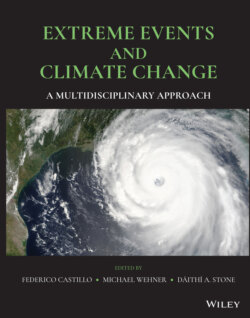Читать книгу Extreme Events and Climate Change - Группа авторов - Страница 22
1.4. IMPLICATIONS FOR THE FUTURE
ОглавлениеThis chapter has focused mainly on the past, specifically about detection and attribution of changes. This places heavy burdens on the evidence base that has the advantage of producing coherent, strongly supported conclusions, but it also has the disadvantage of being unable to provide information on some types of impacts. Does this matter when predicting future risk? After all, predictions concerning risks related to the extreme RFC were made many years before the first assessments of changes in past risks.
First, as time elapses further from the initiation of the UNFCCC process in 1992, we need to know whether we are meeting the UNFCCC’s objective of preventing “dangerous anthropogenic interference with the climate system.” In other words, we will need to continually update our documentation of how anthropogenic emissions are affecting various aspects of human, managed, and natural systems around the world. This is fundamentally the detection and attribution problem, and hence not only requires understanding of how the world works but also monitoring how everything is (or is not) changing.
As for the relevance for predicting the future, it helps to consider conditions under which detection and attribution analysis provides inconclusive results and to consider those conditions in the context of understanding future risks. There are three possible reasons for detection and attribution analysis to provide inconclusive results: poor monitoring, poor understanding of how the system operates, or bad luck (the observations and understanding do not match because of a statistical fluke). Poor understanding will be just as relevant for errors in predicting the future as they are for the past, in fact, perhaps more so because those errors are likely to be amplified as the climate change signal and other signals become stronger. Statistical flukes occur because the analysis is inherently probabilistic in nature but ought to happen rarely. It does remind us that specific aspects of the predicted future may not materialize in the end simply because the climate and various impact systems are inherently chaotic. Poor monitoring is also relevant, though, because if we do not have a reliably observed baseline and if we do not obtain reliable observations of future states, then we will lack an important input in the process of refining later predictions. The ability to calibrate predictions by evaluating against past behavior, that is, through detection and attribution analysis, will be especially important for our assessment of risk in cases where understanding remains poor in the future.
This chapter has focused on types of synthesis assessments that might be useful for informing the UNFCCC process or some similar global, multisectoral interest. Of course, synthesis assessments might be useful for other audiences too. At the national or a subnational administrative level, synthesis assessments may have a similar purpose, that is, informing the development and monitoring of the effectiveness of government policy, and so such syntheses might take a similar form to a UNFCCC‐motivated synthesis. However, syntheses relevant for industries, whether for large company, industry organizations, or government ministries, may have a more restricted remit in terms of types of impacts. That may mean that a single quantitative metric, such as insured monetary losses, is applicable. In these cases, there may be a clear and obvious method for performing a synthesis, too.
Given the diversity in what is required of synthesis assessments, this chapter has refrained from specific recommendations that might be relevant only for a very particular class of assessment. Instead, there are some broad general guidelines that should considered in the future. The urgent priority is to promote the operation of comprehensive monitoring programs: measurements for a given date are not something that can be deferred to later. Both monitoring and the development of mechanistic understanding are standard components of disciplinary analysis, and so there may be more important disciplinary motivations for them. But it is worth reminding ourselves that syntheses cannot be performed without these pillars. In addition, there have been two other themes running through this chapter that are specific to synthesis. The first theme is the usefulness of a clearly delineated remit. The focus on extreme weather here might be considered arbitrary, but a synthesis of climate change impacts that are mediated through extreme weather fits into current decision‐making systems in a way that might make the synthesis more useful. The second theme is the need for further development of synthesis methods (Kowarsch & Jabbour, 2017). Possibly the most important recommendation though is to make synthesis assessments into evolving monitoring products. Recent global, cross‐sectoral synthesis assessments have each been a snapshot of a period in time and have not been followed up with periodic operational updates. If we are to be able to document our progress in limiting or avoiding “dangerous” interference, we need continual updates documenting the evolving nature of the impacts from that interference.
